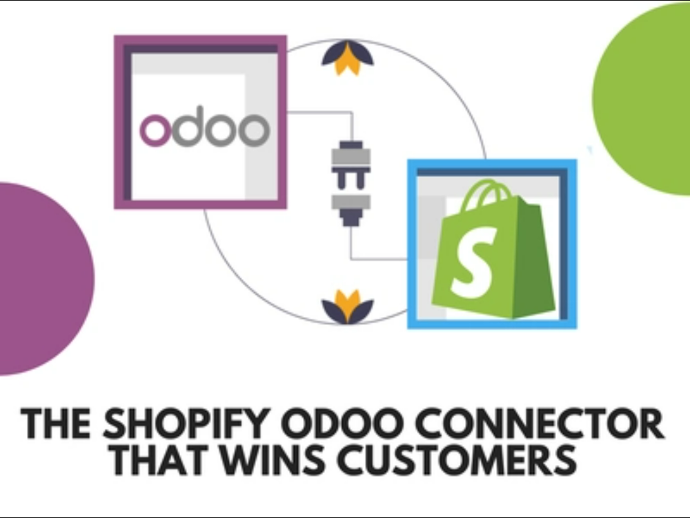Streamline Your Shopify Store with Powerful Odoo Integration

In the competitive world of e-commerce, efficiency and smooth operations are key to long-term success. Many Shopify store owners face challenges in managing various business functions such as inventory, customer relations, accounting, and shipping. These challenges often lead to operational inefficiencies that affect both customer experience and business growth. Integrating Odoo with Shopify can be a game-changing solution, allowing businesses to streamline processes, improve efficiency, and enhance customer satisfaction.
Odoo is an all-in-one business management software that provides powerful tools for inventory, sales, accounting, customer relationship management (CRM), and more. By integrating Odoo with Shopify, store owners can automate workflows, centralize data, and create a seamless connection between their online store and back-office operations. In this article, we’ll explore how Shopify store owners can benefit from Odoo integration and how this powerful combination can optimize business performance.
Why Integrate Shopify with Odoo?
Integrating Shopify with Odoo offers several advantages that go beyond basic website functionality. While Shopify is an excellent platform for building and managing an online store, it often requires third-party tools to handle other critical business functions. This can lead to fragmented workflows, data silos, and increased manual labor.
Odoo, on the other hand, offers a suite of integrated applications that can handle everything from inventory management to sales tracking and accounting. By integrating Odoo with Shopify, businesses can bring all their essential operations under one roof. Here are some key benefits of this integration:
1. Automated Inventory Management
Inventory management is a crucial part of running an e-commerce store, and manual updates can lead to mistakes like overselling or running out of stock. With Odoo’s powerful inventory management system integrated with Shopify, you can automate the entire process.
The integration ensures that when a customer makes a purchase on Shopify, Odoo automatically updates the stock levels across all your channels. This means no more manually updating your inventory and fewer chances for errors. You can track your stock in real-time, set automatic reordering rules, and manage your products more efficiently, allowing you to focus on growing your business.
2. Seamless Accounting and Financial Management
One of the most challenging aspects of running an online store is keeping track of finances, especially when you have multiple payment gateways and sales channels. Integrating Shopify with Odoo allows for seamless financial management, giving you real-time access to financial data.
Odoo’s accounting module is highly robust and customizable, offering automated invoice generation, payment tracking, and real-time reporting. This integration ensures that every sale made on Shopify is automatically recorded in your accounting system. It also provides insight into profit margins, cash flow, and other critical financial metrics, helping you make better business decisions.
3. Efficient Order Processing and Fulfillment
With Odoo integration, Shopify orders are automatically synced with Odoo’s backend system, ensuring efficient order processing and fulfillment. Odoo allows you to track every stage of the order lifecycle, from payment processing to shipping.
By integrating with Odoo, your fulfillment process becomes more streamlined. Orders placed on Shopify can automatically trigger workflows in Odoo for picking, packing, and shipping. You can manage shipping carriers, print labels, and track deliveries—all from one place. This reduces the need for manual intervention and ensures that customers receive their products faster, improving their overall experience.
4. Customer Relationship Management (CRM)
Understanding your customers and building strong relationships with them is critical for e-commerce success. Shopify-Odoo integration offers a powerful CRM solution that helps you keep track of customer interactions, purchase history, and preferences.
Odoo’s CRM system allows you to segment your customers, create targeted marketing campaigns, and track interactions across all channels. By integrating this with Shopify, you can gain valuable insights into customer behavior and tailor your marketing efforts to increase retention and conversion rates. The more you know about your customers, the better you can serve them, and the more loyal they become to your brand.
5. Centralized Data and Analytics
One of the main challenges of running an e-commerce store is managing data from different systems. Shopify and Odoo integration solves this issue by centralizing all your data in one place. Whether it’s sales, customer information, inventory, or financial data, everything is stored and managed through Odoo’s backend.
With centralized data, you can generate detailed reports and gain insights into how your business is performing. Odoo’s analytics tools help you track key performance indicators (KPIs) such as sales trends, conversion rates, inventory turnover, and more. This integration gives you the visibility needed to make informed decisions and optimize business performance.
6. Scalability for Growing Businesses
As your Shopify store grows, so do your operational needs. The scalability of the Shopify-Odoo integration allows your business to handle increased demand without compromising efficiency. Odoo’s modular structure means you can add new functionalities as your business expands. Whether you need to manage more products, handle higher order volumes, or expand to multiple locations, the integration is flexible enough to grow with your business.
This scalability ensures that your store remains agile and capable of adapting to new market trends, giving you a competitive edge in the fast-evolving world of e-commerce.
Key Features of Shopify-Odoo Integration
The Shopify-Odoo integration offers a wide range of features that can significantly improve the efficiency and functionality of your e-commerce store. Some of the key features include:
- Real-time data synchronization: Orders, inventory, customer information, and financial data are synced in real-time between Shopify and Odoo.
- Automated workflows: Automation of key processes such as inventory updates, order fulfillment, and accounting tasks.
- Customizable modules: Odoo’s modular architecture allows you to choose and configure the tools that fit your business needs.
- Comprehensive reporting: Gain insights into sales, inventory, customer behavior, and financial performance with advanced reporting and analytics tools.
- Multi-channel management: Manage multiple sales channels and e-commerce stores from a single platform, ensuring consistency and efficiency.
Conclusion
Integrating Odoo with Shopify is a powerful way to streamline your business operations and take your e-commerce store to the next level. From automating inventory management to improving customer relationships and centralizing data, this integration allows you to create a more efficient, scalable, and profitable business.
By leveraging the capabilities of Odoo, Shopify store owners can focus on what matters most: growing their business and enhancing the customer experience. Whether you are a small business looking to optimize your workflows or a larger enterprise needing more advanced features, the Shopify-Odoo integration is the solution you need to succeed.
For businesses looking for expert guidance in implementing this powerful integration, Index World offers the ultimate all-in-one business solution in the Odoo industry. With deep expertise in Odoo and a commitment to helping businesses thrive, Index World ensures a smooth and efficient integration process, allowing you to unlock the full potential of your Shopify store with Odoo’s advanced capabilities.



